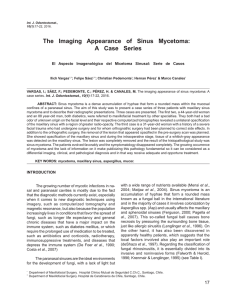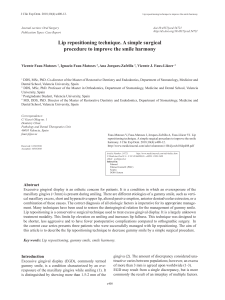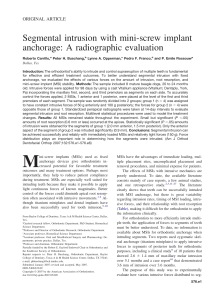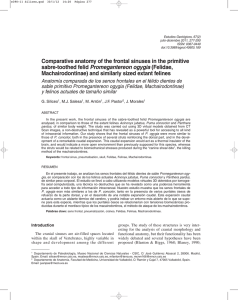Unusual Sinonasal Foreign Body: Presentation of Three Cases
Anuncio
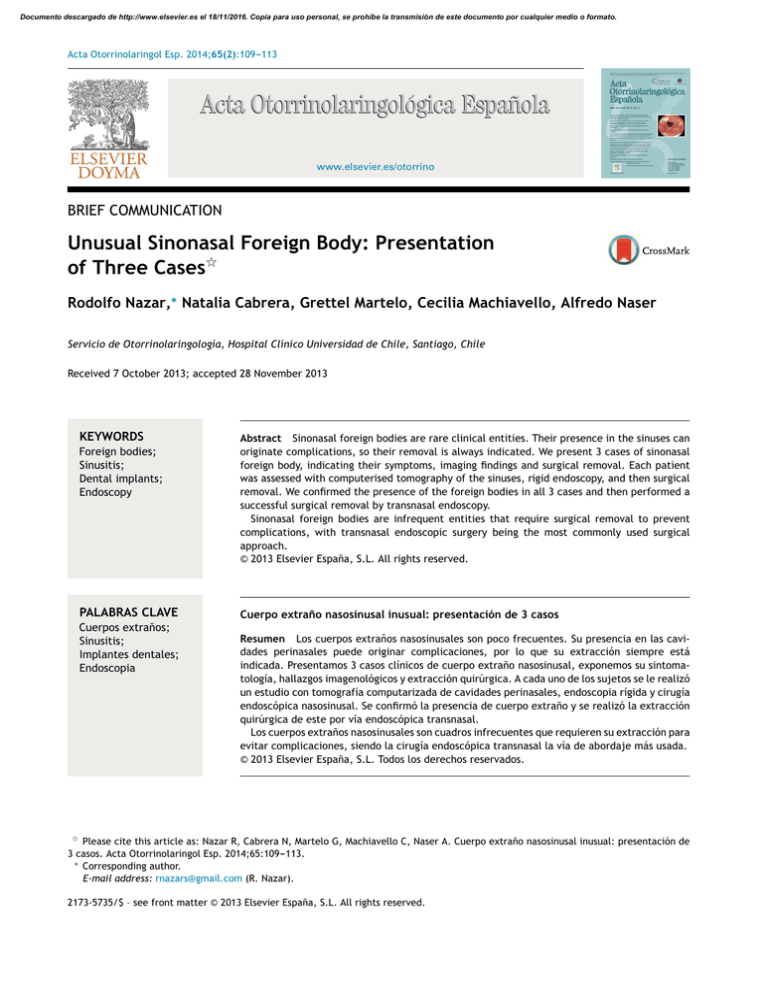
Documento descargado de http://www.elsevier.es el 18/11/2016. Copia para uso personal, se prohíbe la transmisión de este documento por cualquier medio o formato. Acta Otorrinolaringol Esp. 2014;65(2):109---113 www.elsevier.es/otorrino BRIEF COMMUNICATION Unusual Sinonasal Foreign Body: Presentation of Three Cases夽 Rodolfo Nazar,∗ Natalia Cabrera, Grettel Martelo, Cecilia Machiavello, Alfredo Naser Servicio de Otorrinolaringología, Hospital Clínico Universidad de Chile, Santiago, Chile Received 7 October 2013; accepted 28 November 2013 KEYWORDS Foreign bodies; Sinusitis; Dental implants; Endoscopy PALABRAS CLAVE Cuerpos extraños; Sinusitis; Implantes dentales; Endoscopia Abstract Sinonasal foreign bodies are rare clinical entities. Their presence in the sinuses can originate complications, so their removal is always indicated. We present 3 cases of sinonasal foreign body, indicating their symptoms, imaging findings and surgical removal. Each patient was assessed with computerised tomography of the sinuses, rigid endoscopy, and then surgical removal. We confirmed the presence of the foreign bodies in all 3 cases and then performed a successful surgical removal by transnasal endoscopy. Sinonasal foreign bodies are infrequent entities that require surgical removal to prevent complications, with transnasal endoscopic surgery being the most commonly used surgical approach. © 2013 Elsevier España, S.L. All rights reserved. Cuerpo extraño nasosinusal inusual: presentación de 3 casos Resumen Los cuerpos extraños nasosinusales son poco frecuentes. Su presencia en las cavidades perinasales puede originar complicaciones, por lo que su extracción siempre está indicada. Presentamos 3 casos clínicos de cuerpo extraño nasosinusal, exponemos su sintomatología, hallazgos imagenológicos y extracción quirúrgica. A cada uno de los sujetos se le realizó un estudio con tomografía computarizada de cavidades perinasales, endoscopia rígida y cirugía endoscópica nasosinusal. Se confirmó la presencia de cuerpo extraño y se realizó la extracción quirúrgica de este por vía endoscópica transnasal. Los cuerpos extraños nasosinusales son cuadros infrecuentes que requieren su extracción para evitar complicaciones, siendo la cirugía endoscópica transnasal la vía de abordaje más usada. © 2013 Elsevier España, S.L. Todos los derechos reservados. 夽 Please cite this article as: Nazar R, Cabrera N, Martelo G, Machiavello C, Naser A. Cuerpo extraño nasosinusal inusual: presentación de 3 casos. Acta Otorrinolaringol Esp. 2014;65:109---113. ∗ Corresponding author. E-mail address: rnazars@gmail.com (R. Nazar). 2173-5735/$ – see front matter © 2013 Elsevier España, S.L. All rights reserved. Documento descargado de http://www.elsevier.es el 18/11/2016. Copia para uso personal, se prohíbe la transmisión de este documento por cualquier medio o formato. 110 Introduction Nasal foreign bodies (NFBs) constitute an unusual reason for ENT consultation; however, they are important clinically due to the wide range of complications they can produce, which is why their extraction is almost always indicated.1,2 Their clinical presentation is usually symptoms of unilateral rhinosinusitis or they are incidental imaging findings, so their diagnosis requires a high degree of suspicion.1 The main aetiologies of NFBs are odontogenic, such as dental implants, and non-odontogenic, related to penetrating facial traumas.1 A complete study with computed tomography (CT) scan of perinasal cavities and rigid endoscopy should be performed before deciding upon the type of procedure to be carried out for their removal.1,2 We present 3 NFB cases patients at the Otorhinolaryngology Service of the Hospital Clínico at the University of Chile, who consulted for rhinorrhoea and nasal obstruction, both unilateral and bilateral, between 2011 and 2012. All 3 patients received a study with rigid nasal endoscopy and CT of the perinasal cavities, with a diagnosis of the presence of 1 or more NFBs. Surgical extraction was planned and performed based on the characteristics of the foreign body or bodies. Case 1 The first is a 67-year-old male, with a history of multiple surgeries for dental implants and functional endoscopic surgery (2005) to extract a dental implant in the right maxillary sinus; he consulted for symptoms that had lasted for 3 years characterised by bilateral maxillary pain, intermittent purulent rhinorrhoea and nasal obstruction. The CT of the perinasal cavities revealed 3 dental implants located in both maxillary sinuses (2 in the left maxillary sinus and 1 in the right maxillary sinus) associated with bilateral maxillary opacification (Fig. 1a). Functional endoscopic surgery was performed, consisting of an uncinectomy with wide maxillary antrostomy and anterior R. Nazar et al. ethmoidectomy; the 3 implants were then extracted endoscopically using transnasal approach (Fig. 1b and c). Case 2 The second case is a 60-year-old male, with a history of recurrent rhinosinusitis and nose surgery for ozena with use of grafts (1992); patient consults for long-lasting nasal obstruction and purulent rhinorrhoea. The presence of multiple rhinoliths in the right nostril was revealed by CT (Fig. 2a). Functional endoscopic surgery was performed, confirming the presence of multiple calcified silicone grafts, extruded in right nostril and removing them endoscopically (Fig. 2b and c). Case 3 The third case is a 35-year-old male patient, lacking morbid antecedents, who consulted due to history and rhinorrhoea and maxillary pain at a primary health centre; simple X-rays of the perinasal cavities were requested, with the finding of a needle in the left maxillary sinus (Fig. 3a). The patient did not know the origin of this foreign body. When he came to our ENT service, CT of perinasal cavities was requested, which confirmed the presence of an object with the shape of a needle in the left maxillary sinus towards the ethmoids, almost reaching the base of the skull (Fig. 3b). During functional endoscopic surgery, pus from the middle meatus was observed, so uncinectomy, maxillary antrostomy, anterior ethmoidectomy and revision of the frontal recess were performed. In the ethmoidectomy, the presence of a needle coming from the maxillary sinus was seen; it was removed without incident. The needle was 5 cm long (Fig. 3c and d). Discussion In this communication we present 3 cases of rare NFBs. One of them was of odontogenic origin and the other 2 were non-odontogenic. In 2 clinical cases (Cases 1 and 2), there Figure 1 (a) Computed tomography scan, axial cut showing the 3 dental implants in both maxillary sinuses. You can see maxillary opacification; (b) transnasal endoscopic removal of the implants in the left maxillary sinus; and (c) dental implants removed. Documento descargado de http://www.elsevier.es el 18/11/2016. Copia para uso personal, se prohíbe la transmisión de este documento por cualquier medio o formato. Unusual Sinonasal Foreign Body: Presentation of Three Cases 111 Figure 2 (a) Computed tomography scan, coronal cut showing the ozena grafts extruded in the right nasal fossa; (b) transnasal endoscopic removal of the implants in the right nasal fossa; and (c) ozena graft removed. was suspicion of foreign body due to the presence of previous operations. The third case was an imaging finding. The 3 cases were treated by removal of the NFBs via nasal endoscopy, which is the procedure of choice when it is possible. The incidence of sinonasal foreign bodies is unknown, as they are seldom found in normal clinical practice; this is in contrast to foreign bodies in the nose, which is why most of the works published correspond to isolated cases.1 The most frequent anatomical location is the maxillary sinus (approximately 50%), with the frequency being similar in the other perinasal cavities.3 With respect to aetiology, it can be divided into 2 groups: odontogenic and non-odontogenic.1 The majority of the NFBs are found in the first group, representing 70%---90% of the cases reported.1 These are principally dental roots, implants, amalgams and cement, which end up in the perinasal cavities by means of apical migration, through the canalicular conduct or accidental manipulation, with the maxillary sinus being affected above all.1,2 In addition, the presence of molars and premolars that grow towards the maxillary antrum has been reported.1 The greatest risk involving implants is produced in the posterior maxillary area, due to the lower bone density in this area.4 In the first aetiological group, there are 2 forms of presentation; the first is an intra-operative accident due to an inadequate technique, prior alveolar infection and bone destruction, while the second way is late migration, related to peri-implantitis or bone resorption.2 It is important to emphasise that foreign bodies can migrate from the maxillary sinus towards other paranasal cavities, the orbital floor or the cranial fossa.5 The second, non-odontogenic, group represents 10%---30% of the cases and is found in close relation with penetrating facial traumas.1 Among the elements reported are bullets, BB pellets, wood, glass, gauze and even penetrating intracranial transnasal foreign bodies.6 The paranasal cavity most affected is the maxillary sinus. A high degree of suspicion is Figure 3 (a) Simple X-ray (occipital---frontal) of perinasal cavities, showing the needle in the left maxillary sinus; (b) computed tomography scan, coronal cut showing the needle in the left maxillary sinus towards the ethmoids, almost reaching the base of the skull; (c) transnasal endoscopic removal of the needle in the left maxillary sinus; and (d) needle removed (5 cm in length). Documento descargado de http://www.elsevier.es el 18/11/2016. Copia para uso personal, se prohíbe la transmisión de este documento por cualquier medio o formato. 112 needed for its diagnosis, given that symptoms can present in a delayed fashion. The pellets and bullets cause chronic irritation of the mucosa from alterations in the ciliary movement, which increases the risk of eventual malignancy, in addition to the risk of lead poisoning.7 Sinonasal foreign bodies are more frequent in adults and their symptoms are of latent initiation. A history of dental procedure or facial trauma (whether recent or in the past) is essential for the initial clinical suspicion. A great majority of cases are asymptomatic, presenting as a radiological finding.1 When there are symptoms, these generally appear as unilateral rhinosinusitis, with nasal obstruction, a sensation of pressure and/or fullness of the face, purulent rhinorrhoea, cacosmia and hyposmia.1 Unilateral purulent rhinorrhoea, polypoid degeneration of the mucosa and mucosa congestion can be seen in anterior rhinoscopy.1 It is important to emphasise that some 5%---15% of unilateral maxillary sinusitis cases are caused by odontogenic NFBs.2 Insofar as examinations for diagnostic help, rigid endoscopy is essential, as it makes it possible to evaluate the osteomeatal complex.1,2 As for imaging, the gold standard is CT of the paranasal cavities, as it permits making the diagnosis, characterising the foreign body and establishing FB location and relation with anatomic landmarks, as well as the presence of associated sinusitis. All of this is necessary for planning appropriate extraction.2 Nuclear magnetic resonance imaging is indicated when there is suspicion of organic, wooden or plastic foreign body.8 The most frequent published complication is the presence of recurrent unilateral sinusitis, which is even considered as the first manifestation of NFBs produced by ciliary insufficiency and secondary infection.9 Within this same group, the presence of aspergillum has been described; it has been posed that the presence of zinc in dental material dental might favour the development of Aspergillus spp.10 The formation of antroliths, calcified masses in a paranasal cavity, is the result of the deposit of mineral salts around a nucleus. They are fairly frequent in the presence of foreign bodies, as these acts as nuclei of formation. Antroliths can present as findings or associated with symptoms such as headache, face pain, nasal obstruction, cacosmia, purulent rhinorrhoea and epistaxis.11 In CT they appear as opaque masses accompanied by secretion and even polyps. Other complications that have been described include cutaneous and fistula, mucocele and pyomucocele, ulcers, carcinoma of the maxillary sinus, chemical lead poisoning and metallosis, facial neuralgia, amaurosis, meningoencephalitis complications and even cerebrospinal fluid fistula.9 Treatment for all NFBs is extraction, even if the NFB is asymptomatic, in order to avoid complications. The removal can be through open (Caldwell-Luc procedure) or endoscopic approaches, both transoral and transnasal.2 The first-line therapy is endoscopic approach, as it is less invasive. There are 2 main types of endoscopic approach, transoral and transnasal.2 The transoral route is a useful approach for gaining access to the maxillary sinus, although it is limited to cases without sinusitis, without ostium involvement, and/or with a small R. Nazar et al. foreign body.2 The technique requires local anaesthesia plus sedation; access is through the canine fossa using a trocar that penetrates the anterior wall of the maxillary sinus and inserting a 30◦ and 70◦ rigid endoscope to examine the cavity and then introducing a 0◦ lens to insert the trocar that will remove the foreign body.12 The biggest disadvantage of this technique is the limited visual field.2,12 The transnasal approach makes it possible to gain access to the maxillary sinus and other structures involved, such as the frontal, ethmoid and sphenoid sinuses.13 It can be used when the ostium is involved and there is associated sinusitis, permitting simultaneous treatment of the paranasal cavities and nasal mucosa.13 The technique requires local anaesthesia and sedation, it is less invasive and allows rapid recovery; its main disadvantage is the possibility of later formation of synechiae.13 The open approach is performed principally by means of the Caldwell---Luc procedure. This is the procedure of first choice when the NFB is large and is inaccessible using endoscopic techniques, in patients having only maxillary sinus involvement and lacking ostium involvement.2 The technique is performed with local or general anaesthesia, making a vestibular incision from the canine to the first molar, forming a mucoperiosteal flap that exposes the canine fossa and then making a 4---5 mm bone window and removing the foreign body with a suction point. The main disadvantages are later sensory alterations, facial asymmetry and dental alterations. Diagnostic suspicion is important in NFBs and their surgical extraction is always indicated because of their possible complications. The entry route always depends on the individual case, but nasal endoscopy is the option of choice. Conflict of Interests The authors have no conflicts of interest to declare. References 1. Bodet E, Viza I, Romeu C, Martínez V. Foreign bodies in maxillary sinus. Acta Otorrinolaringol Esp. 2009;60:190---3. 2. González A, González J, Diniz M, García A, Bullón P. Accidental displacement and migration of endosseous implants into adjacent craniofacial structures: a review and update. Med Oral Patol Oral Cir Bucal. 2012;17:e769---74. 3. Mangwani J, Su AP. Late presentation of a paranasal sinus glass foreign body: a case report. Cases J. 2009;2:6483. 4. Kitamura A, Zeredo J. Migrated maxillary implant removed via semilunar hiatus by transnasal endoscope. Implant Dent. 2010;19:16---20. 5. Felisati G, Lozza P, Chiapasco M, Borloni R. Endoscopic removal of an unusual foreign body in the sphenoid sinus: an oral implant. Clin Oral Implants Res. 2007;18:776---80. 6. Hoon D, Seo B, Chul S. Endoscopic treatment of transnasal intracranial penetrating foreign body. J Craniofac Surg. 2011;22:1800---1. 7. Stott C, Zúñiga J, Esquivel P, Elgueta F. Balín como cuerpo extraño en cavidades paranasales. Rev Otorrinolaringol Cir Cabeza Cuello. 2005;65:139---43. 8. Simha A, John M, Rita R, Kuriakose T. Orbito-sinal foreign body. Indian J Ophthalmol. 2010;58:530---2. 9. Scolozzi P, Momjian A, Lombardi T. Removal of unusual, large high-velocity metallic maxillary sinus foreign bodies by a Documento descargado de http://www.elsevier.es el 18/11/2016. Copia para uso personal, se prohíbe la transmisión de este documento por cualquier medio o formato. Unusual Sinonasal Foreign Body: Presentation of Three Cases modified free bone flap technique. Eur Arch Otorhinolaryngol. 2010;267:317---20. 10. Burnham R, Bridle C. Aspergillosis of the maxillary sinus secondary to a foreign body (amalgam) in the maxillary antrum. Br J Oral Maxillofac Surg. 2009;47:313---5. 11. Güneri P, Kaya A, Caliskan MK. Survey of the literature and report of a case. Oral Surg Oral Med Pathol Oral Radiol Endod. 2005;99:517---21. 113 12. Pagella F, Emanuelli E, Castelnuovo P. Endoscopic extraction of a metal foreign body from the maxillary sinus. Laryngoscope. 1999;109:339---42. 13. Chiapasco M, Felisati G, Maccari A, Borloni R, Gatti F, di Leo F. The management of complications following displacement of oral implants in the paranasal sinuses: a multicenter clinical report and proposed treatment protocols. Int J Oral Maxillofac Surg. 2009;38:1273---8.
